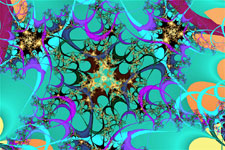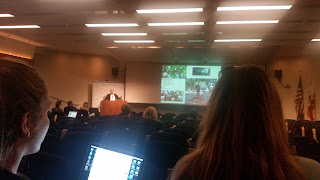Blog 2- Math, Art and Science
 |
| (Jackson Pollack Fractal) |
Surprisingly, math, art, and science are commonly intertwined as seen in fractals, the Golden Ratio, and in hyperbolic crochet. A fractal, “...is composed of a singular geometric pattern repeated thousands of times” (Ouellette). This is a mathematical idea that has been made into art and paintings as seen in the TV show White Collar. Fractals have also been seen in nature in the river and tree branches, and in the destruction caused by a hurricane (Ouellette). Next, the Golden ratio, or phi, is commonly used. This number is 1.618... and is seen in the Fibonacci sequence. The sequence starts with 1,1,2,3,5,8...and the higher up you go, the ratio goes closer to the Golden Ratio (mathisfun.org). This ratio creates a spiral that is seen in art to create correct propositions in paintings. This is also seen in nature with flower petals, flower seeds, spiral galaxies, and DNA. Finally, this is seen in the hyperbolic crochet. While mathematicians knew the hyperbolic space existed, it was almost impossible for them to show it (crochetcoralreef.org). In 1997, Dr. Daina Taimina was able to create this by using crochet and produced a book on her work.
 |
| (Hyperbolic Crochet) |
The advertisement by Lemongraphic for Terkaya Wealth management is an example of technology and the Golden ratio (Gross). The size and placement of the writing and the picture of the eagle was done on purpose and planned due to the Golden rule. Gross also has other examples of the Golden Rule used in artwork, and this made me realize how common it is. The use of graphic art and the knowledge of the Golden ratio made this artwork possible
| (Terkaya by Lemongraphic) |
It
also made me realize how common math is used in types of art, as seen
in Leonardo Da Vinci’s use of the Golden Ratio in The Mona Lisa and
Jackson Pollack’s use of fractals in his paintings. I also noticed that
modern artists create most of their work by using certain programs on
the computer to help aid them, like Lemongraphic.
 |
| (Understanding the Golden Ratio in Designs) |
Finally, artists use juxtaposition in their work to bring attention to a certain quality or to make an effect (South). An example of this is seen in the picture below. We see the bright colored photo of the top of a tree placed on top of a black and white photo of a explosion from a bomb. The contrast is the man made object that is dull symbolizes destruction and death, while the vibrant colors from the tree show life and happiness. It is interesting to see how the artist took a photo of a bomb and made it look like a tree.
| (Juxtaposition- Nature vs. War) |
Sources
Crochet Coral Reef. Hyperbolic Crochet. Photograph.
"Daina Taimina." Daina Taimina | Crochet Coral Reef. Crochet Coral Reef, Apr. 2009. Web. 16
Apr. 2017.
Design School. Terkaya by Lemongraphic. Photograph.
Fantastic Fractals. Jackson Pollack Fractals. Photograph.
Gross, Rebecca. "What Is The Golden Ratio? What You Need to Know and How To Use It."
Design School. N.p., 22 Oct. 2015. Web. 16 Apr. 2017.
Helen South's Drawing/Sketching. "Understanding Juxtaposition." ThoughtCo. N.p.,
11 Oct. 2016. Web. 16 Apr. 2017.
Instantshift. Understanding the Golden Ratio in Designs. Photograph.
"Nature, The Golden Ratio, and Fibonacci Too ..." Nature, The Golden Ratio and Fibonacci
Numbers. Mathisfun, n.d. Web. 15 Apr. 2017.
Ouellette, Jennifer. "May 2017." Pollack's Fractals. Discover Magazine, n.d. Web. 15 Apr. 2017.
Pinterest. Nature vs. War. Photograph. <https://www.pinterest.com/pin/82894449361304192/>


That is so interesting that no one was able to reproduce the hyperbolic space until Dr. Daina Taimina crocheted it -- I had no idea! That is another great example of how art, such as needlework or crocheting, serves as an outlet for mathematics. Also, initially looking at the advertisement I thought that it was aesthetically pleasing, but did not think much of why. It is so compelling that it is soothing to the eye because of math!
ReplyDelete